Pineapple Growing
How To Plant, Care For And Multiply Your Pineapples
Most beginners start pineapple growing by planting the tops of shop bought pineapples.
That's a good way to play around and doesn't cost anything. If you eat pineapples you have the tops left over anyway.
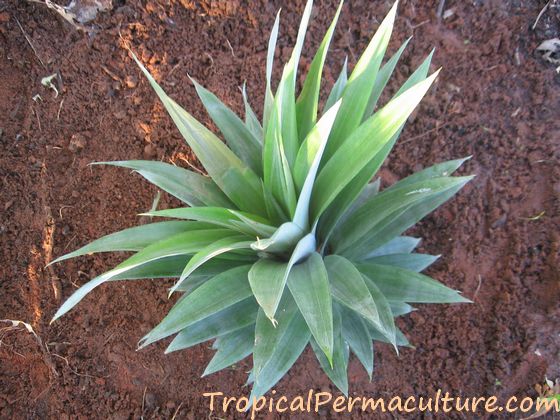
However, growing pineapple tops is a slow way to grow pineapples. Tops take at least 24 months to flower, and then it takes another six months for the fruit to mature.
Suckers (or pups) and slips grow up and fruit a lot quicker. You may have to wait for your first top grown plants to produce such offspring.
But if you live in a pineapple growing area you should be able to get hold of some suckers. Beg or steal them of one of the growers. Heck, buy some if you have to!
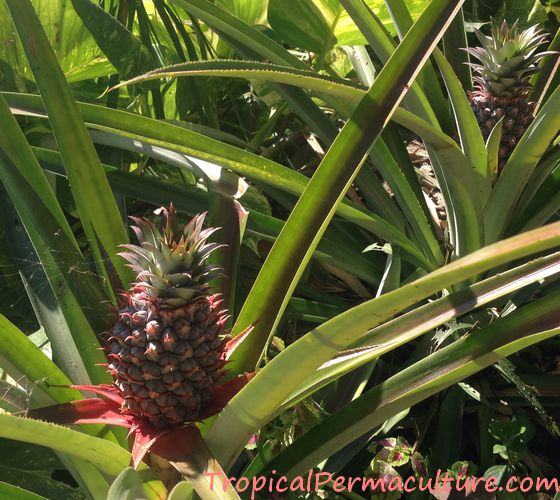 Pineapples growing in the garden of my reader Lisa Preschel from Mexico. ©
Pineapples growing in the garden of my reader Lisa Preschel from Mexico. ©Growing Pineapples From Suckers
A pineapple plant flowers only once, and produces one pineapple. Then it dies. But before it dies it also produces offspring.
Suckers or pups are little plantlets that grow between the leaves of the mature pineapple.
Some varieties will produce more suckers than others, some will start earlier and others later.
But they all produce at least a few suckers or pups before they die.

If you leave the suckers in place you get what is called a "ratoon crop". That is the least amount of work for the next crop, just do nothing. But it has a few disadvantages.
The plants start to crowd each other out and to compete for food, light and water. As a result the next lot of pineapple fruit is much smaller.
The other disadvantage is that if you leave the suckers in place you only get a few. The original pineapple plant thinks it has fulfilled its purpose in life and reproduced, and it dies.
Keep taking the suckers off and the plant keeps growing more of them.
The timing is not critical. I have accidentally broken off tiny baby plants and they survived. It is best to wait though until they are a reasonable size, say about 20 cm/8 inches long.
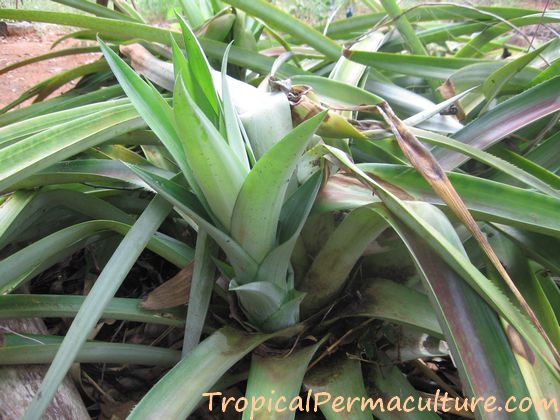
Once they look like the one in the picture above it is definitely time to take them.
I just go around my garden every two or three months and take off all the big suckers I see. Grab hold of them as close to the base as possible, and twist and pull at the same time. They usually come off easily. And then plant them like you plant pineapple tops. Just stick them in the ground. They'll grow :-).
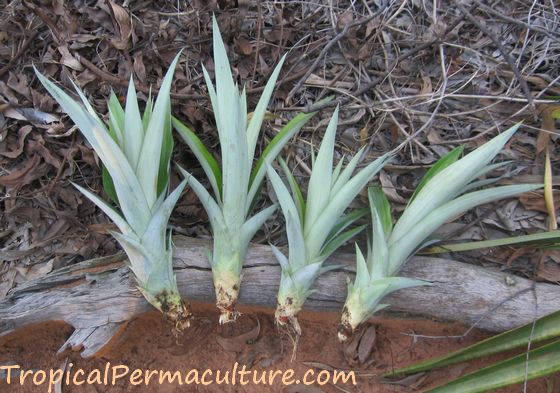 Pineapple suckers ready for planting.
Pineapple suckers ready for planting.Pineapple Growing From Slips
Pineapple slips... In my early pineapple growing days I could never figure out what or where they were supposed to be!
Slips are the tiny plantlets that grow at the base of the fruit on the fruit stalk.

The reason I couldn't find them is that not all pineapple varieties produce slips.
Shop bought pineapples in Australia are usually of the variety "Smooth Cayenne", and they grow few if any slips. (They also produce few suckers and take a long time to do so.)
I eventually managed to get hold of another variety, the "Rough Cayenne". (You can not find that one in our shops, I got it from a friend). The Rough Cayenne produces much smaller but very tasty fruit, it has very prickly leaves, and lots of slips below the fruit.
Slips can be carefully snapped or pulled off. Do it as soon as they are big enough to handle (say about 10 to 15 cm/4-6 inches) because slips develop at the expense of the fruit! This means if you leave them on, your fruit will be smaller.
Plant them the same way you plant tops and suckers.
Your pineapple plant will not continue to produce more slips if you remove them as it does with suckers. Once you take the slips off you are done and the plant will put all its energy into the fruit.
Pineapple Growing Strategies
I imagine that initially you will carefully plant out every single sucker and slip your pineapple plants produce. I sure did. But soon your garden will be full of pineapples and you can afford to be more selective.
Mark the plants that produced the biggest, sweetest and juiciest fruit so you know those suckers are worth planting.
Avoid the plants that produce long fruit stalks, like the one in the picture below. The fruit should grow as low as possible or it just falls over and gets sunburned.

While it's tempting to initially select for plants that produce lots of slips, keep in mind that the slips develop at the expense of the fruit. You get bigger, better fruit of plants that produce fewer slips.
Pineapple plants have a tiny root system and rely a lot on their leaves for water and nutrition. Therefore they don't mind being dug up and transplanted.
You can use that to your advantage by planting your small suckers and slips into a "nursery bed". They won't stay there for long so you can plant them very close together.
Wait for them to grow to about a foot high before you plant them in their final position. That way all the pineapples in a clump or row are of similar size and you don't get the big ones crowding and shading the littlies.
(I don't have a photo of that because I'm too lazy to do it, but it sure is a smart strategy. Maybe I should finally try it out...)
Smooth Cayenne is by far the most popular variety across the world and the most common in the shops. It's a very reliable producer of large and great tasting fruit and it has the smoothest leaves.
(If you haven't mulched your pineapples well and have to deal with weeds amongst them you very quickly learn to appreciate that!)
Some of the best tasting pineapple varieties don't ship or keep well and you don't usually get them in shops. So if you see any, or know of someone who grows them, go get them. In Australia that may be a bit hard, but there are hundreds of varieties available across the Americas.
There are also red pineapples, blue pineapples, pineapples with variegated leaves, miniature pineapples, all sorts of pretty and interesting varieties. Have fun trying them out. Just because they are so tasty doesn't mean you have to ignore their beauty!
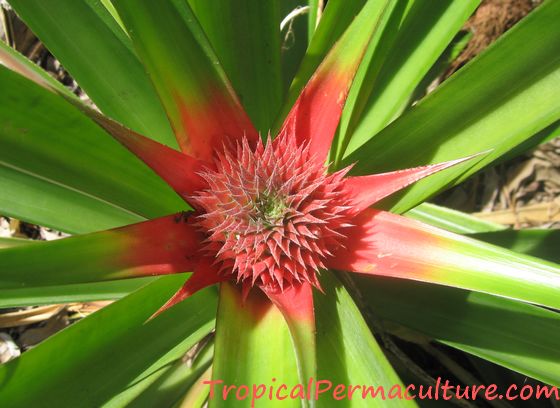
Next: Tips for growing pineapples in a permaculture garden.


